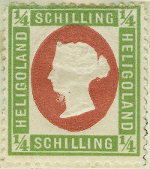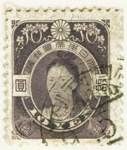
Discussion - Member to Member Sales - Research Center

Discussion - Member to Member Sales - Research Center

Below you will see two stamps from the Serbian 1904 set (Scott #79-86). The first five stamps from this set show Karageorge and King Peter I. King Peter I ascended to the throne after the assassination of King Alexander in 1903.

Why are these stamps called the "Serbian Death Stamps"? Look at the two portraits on the top stamp. Now look at the portraits of the stamp on the bottom. The inverted orientation of the image of the stamp is intentional. With each of these five stamps inverted, one can see a face on the right side of the portraits. Look directly below the neck on the right. The face is purported to be that of the murdered King Alexander.
Some say that the image is purely accidental, while others say that the engraver purposely added the image to the stamps. The engraver denied it. Either way one chooses to believe the story, it is eerie that an image (a third portrait) does appear on the stamp.
(NOTE: This post was edited by the original writer to provide a better image of the stamps.)

2 Members
like this post.
Login to Like.
Here is another installment. This time some stamps from Latvia.
Many hear me complain about people writing on the backs of stamps. Also sometimes, stamps get stuck together with parts of the stamp design transferring onto the back of another stamp.
Check these out:

Plenty of mess on the backs of these stamps, right? Damaged stamps, right? Well, the answer in this situation is no. If you're working on stamps from Latvia and you see things like these on the backs of Latvian stamps, don't throw the stamps away. This is perfectly normal.
The two stamps at the top are Latvia Scott #1 and #2. A paper shortage resulted in Latvia printing the stamps on the back of German military maps. Most of the maps were printed in black and white. If you find a #1 or #2 with a map in color, you have a bonus as the stamp is worth a small premium.
The two stamps on the bottom are an example of several stamps printed by Lativa on the backs of unfinished banknotes. There are all sorts of designs one can find on the backs of these and similarly printed stamps from Latvia.

3 Members
like this post.
Login to Like.
Michael's right: Always check the back of stamps, and look at the inside of covers, and not only because you might find an enclosure.
Another paper shortage, in postwar Great Britain, resulted in a cover that is somewhat interesting on the outside (but not because of the paper shortage, and very interesting on the inside. Here's the outside, franked with more postage metre stamps than I've ever seen on one cover:

It's the inside that caught my attention. I don't often mutilate covers, but this one needed to be exploded; it was made from apparently surplus paper bags made for household salt:

Bob

Login to Like
this post
interesting....I found a personal note inside a FDC one time....just by accident now I always check.....

Login to Like
this post
These (the Serbian stamps) remind me a bit of the John Wesley Harding LP cover which, as those of us of a certain age know, featured 'hidden' portraits of the Beatles. Or not, of course. (see internet images, passim.)

Login to Like
this post

I thought it would be fun to carry this theme to another group of stamps, namely the Serbian "Death Stamps".
Below you will see two stamps from the Serbian 1904 set (Scott #79-86). The first five stamps from this set show Karageorge and King Peter I. King Peter I ascended to the throne after the assassination of King Alexander in 1903.

Why are these stamps called the "Serbian Death Stamps"? Look at the two portraits on the top stamp. Now look at the portraits of the stamp on the bottom. The inverted orientation of the image of the stamp is intentional. With each of these five stamps inverted, one can see a face on the right side of the portraits. Look directly below the neck on the right. The face is purported to be that of the murdered King Alexander.
Some say that the image is purely accidental, while others say that the engraver purposely added the image to the stamps. The engraver denied it. Either way one chooses to believe the story, it is eerie that an image (a third portrait) does appear on the stamp.
(NOTE: This post was edited by the original writer to provide a better image of the stamps.)

2 Members
like this post.
Login to Like.

re: Stamps Are Not What They Seem II
Here is another installment. This time some stamps from Latvia.
Many hear me complain about people writing on the backs of stamps. Also sometimes, stamps get stuck together with parts of the stamp design transferring onto the back of another stamp.
Check these out:

Plenty of mess on the backs of these stamps, right? Damaged stamps, right? Well, the answer in this situation is no. If you're working on stamps from Latvia and you see things like these on the backs of Latvian stamps, don't throw the stamps away. This is perfectly normal.
The two stamps at the top are Latvia Scott #1 and #2. A paper shortage resulted in Latvia printing the stamps on the back of German military maps. Most of the maps were printed in black and white. If you find a #1 or #2 with a map in color, you have a bonus as the stamp is worth a small premium.
The two stamps on the bottom are an example of several stamps printed by Lativa on the backs of unfinished banknotes. There are all sorts of designs one can find on the backs of these and similarly printed stamps from Latvia.

3 Members
like this post.
Login to Like.

re: Stamps Are Not What They Seem II
Michael's right: Always check the back of stamps, and look at the inside of covers, and not only because you might find an enclosure.
Another paper shortage, in postwar Great Britain, resulted in a cover that is somewhat interesting on the outside (but not because of the paper shortage, and very interesting on the inside. Here's the outside, franked with more postage metre stamps than I've ever seen on one cover:

It's the inside that caught my attention. I don't often mutilate covers, but this one needed to be exploded; it was made from apparently surplus paper bags made for household salt:

Bob

Login to Like
this post
07:03:18am
re: Stamps Are Not What They Seem II
interesting....I found a personal note inside a FDC one time....just by accident now I always check.....

Login to Like
this post

re: Stamps Are Not What They Seem II
These (the Serbian stamps) remind me a bit of the John Wesley Harding LP cover which, as those of us of a certain age know, featured 'hidden' portraits of the Beatles. Or not, of course. (see internet images, passim.)

Login to Like
this post

